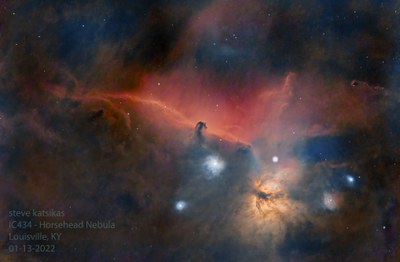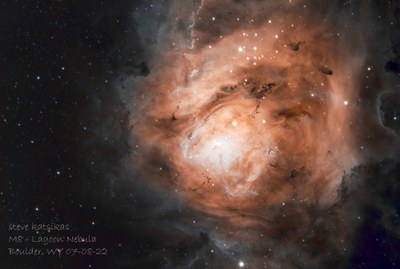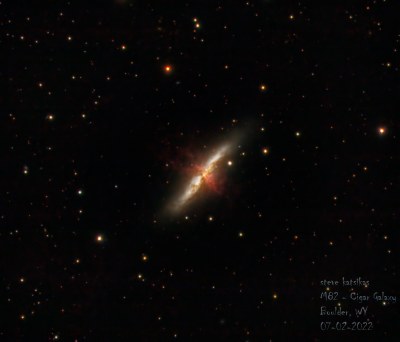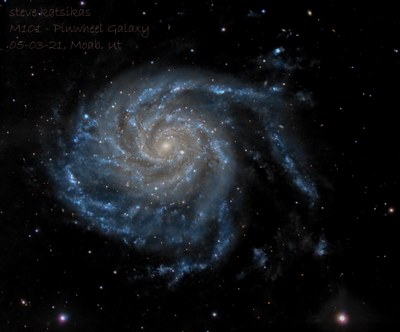Fall 2023
Our first highlighted hobby astronomer is Steve Katsikas. He is a lifelong lover of the night sky and began his interest in astrophotography in 2020 in response to the COVID lockdowns. He is a member of the Louisville Astronomical Society (LAS) and currently serves on their board as Outreach Coordinator. When he is not imaging the night sky from his Louisville driveway (or from darker skies with his camper), he is a clinical psychologist and professor at Spalding University.
 Here we will feature some of Steve’s best images, including the Horsehead Nebula (Barnard 33), Lagoon Nebula (M8), Andromeda Galaxy (M31), Triangulum Galaxy (M33), Cigar Galaxy (M82), and Pinwheel Galaxy (M101).
Here we will feature some of Steve’s best images, including the Horsehead Nebula (Barnard 33), Lagoon Nebula (M8), Andromeda Galaxy (M31), Triangulum Galaxy (M33), Cigar Galaxy (M82), and Pinwheel Galaxy (M101).
All images have been observed with a Celestron EdgeHD 8” Schmidt Cassegrain Telescope, mounted on a Skywatcher EQ6-R (Equatorial) mount for accurately tracking the sky during the night and allowing for long exposures. The setup also includes a guide camera (ASI174mm) to further improve tracking of stars and therefore the quality of the images, a 0.7 reducer to increase the total field of view, and a CCD camera (ASI294MC) to take pictures.
Horsehead Nebula (Barnard 33)
 Is a dark nebula or dust cloud in the constellation Orion, just below the most eastern of the belt stars. It is visible against the backdrop of an actively star forming region filled with mainly ionized hydrogen (HII region). The Horsehead Nebula is about 1,500 ly (light years) from earth and was discovered by the Scottish astronomer Williamina Fleming in 1888.
Is a dark nebula or dust cloud in the constellation Orion, just below the most eastern of the belt stars. It is visible against the backdrop of an actively star forming region filled with mainly ionized hydrogen (HII region). The Horsehead Nebula is about 1,500 ly (light years) from earth and was discovered by the Scottish astronomer Williamina Fleming in 1888.
Steve observed the nebula in January 2020 from Louisville, KY. His final image consists of 50 individual images, each exposed for 300 seconds. He stacked these images to reduce the noise and increase the signal of the source. For processing he used software packages like Astro Pixel Processor, Pixinsight, and for final touches Photoshop. To reduce the negative effect of bright city light, he additionally used an Optolong L-Pro light pollution filter. This filter blocks light mainly emitted by mercury and sodium vapor often found in streetlamps. Steve loves the variety of colors and structure found in the region around the Horsehead Nebula.
Lagoon Nebula (M8) Is a large interstellar cloud in the constellation Sagittarius. It is classified as an emission nebula and HII region, emitting light of ionized hydrogen. Discovered by Giovanni Hodierna in 1654, M8’s is estimated to have a distance to Earth of about 4,000-6,000 ly and a physical size of 55x20 ly.
Is a large interstellar cloud in the constellation Sagittarius. It is classified as an emission nebula and HII region, emitting light of ionized hydrogen. Discovered by Giovanni Hodierna in 1654, M8’s is estimated to have a distance to Earth of about 4,000-6,000 ly and a physical size of 55x20 ly.
The Lagoon Nebula is one of two nebula on the northern hemisphere which can be seen faintly with the naked eye. Spanning roughly 1.5 x 0.67 degrees, it is about 2-3 times the size of the full moon (including its fainter features which cannot be seen be naked eye).
Steve says M8 is difficult to image well, since it is so low above the horizon from our latitude. This challenge was accentuated, since he observed M8 in July 2022 from Boulder, WY. At least the dark skies out West helped with this successful attempt. For Steve this is a special image, since it represents his first attempt to photograph an object in individual filter bands (in this case 3nm wide sulfur, hydrogen, and oxygen filters) and combining them later during the processing to result in a color image. He used the Antlia 3nm SHO filters mounted in a ZWO filter wheel. The final image consists of 11x300s Hydrogen alpha at 656nm or red, 11x300s Oxygen III (two times ionized oxygen) at 500nm or green, and 11x300s of SII (ionized sulfur) at 672nm very red light. With 3nm, the throughput window of the filters is so narrow that they only allow for light of these particular emission lines (OIII, Halpha, SII) to get through. As astronomers we can learn a lot from these types of monochromatic images. In the final image Steve used the Hubble Palette which assigns the OIII to the blue, Halpha to the green, and SII to the red channel in the RGB color space.
Andromeda Galaxy (M31)
 Is a spiral galaxy and our direct neighbor with a distance of 2.5 Mly. M31 has a diameter of 260,000 ly and is significantly larger than our own Milky Way (about 100,000 ly). Like our Milky Way, Andromeda is a member of the so-called local group of galaxies and together they account for 90% of the mass in this group. M31 and the MW are on a collision course and will merge in the far future. Andromeda is visible to the naked eye as a diffuse blob (originally named Andromeda Nebula) and therefore know throughout history. She has first been described by the Persian astronomer Abd al-Rahman al-Sufi around 964, and in 1612 described based on telescope observations by the German astronomer Simon Marius.
Is a spiral galaxy and our direct neighbor with a distance of 2.5 Mly. M31 has a diameter of 260,000 ly and is significantly larger than our own Milky Way (about 100,000 ly). Like our Milky Way, Andromeda is a member of the so-called local group of galaxies and together they account for 90% of the mass in this group. M31 and the MW are on a collision course and will merge in the far future. Andromeda is visible to the naked eye as a diffuse blob (originally named Andromeda Nebula) and therefore know throughout history. She has first been described by the Persian astronomer Abd al-Rahman al-Sufi around 964, and in 1612 described based on telescope observations by the German astronomer Simon Marius.
Steve captured this image of Andromeda in January 2021 from Springfield, KY and shows that one doesn’t have travel far out the city even in Kentucky to get beautiful, deep images of astronomical objects. The final image consists of 60x120s exposures which were combined and processes using a combination of Astro Pixel Processor, Pixinsight, and Photoshop.
Triangulum Galaxy (M33)
 Is a spiral galaxy at a distance of 2.9 Mly from Earth. It is the 3rd largest member of the Local Group with a size of over 50,000 ly. It was most likely first discovered by Giovanni Hodierna before 1654 and later added by Charles Messier to his catalog published in 1771 as object 33 (M33).
Is a spiral galaxy at a distance of 2.9 Mly from Earth. It is the 3rd largest member of the Local Group with a size of over 50,000 ly. It was most likely first discovered by Giovanni Hodierna before 1654 and later added by Charles Messier to his catalog published in 1771 as object 33 (M33).
This images of M33 comes with a story attached. When Steve observed this beautiful galaxy, he rented a farmhouse in the middle of “nowhere” (5 miles from any other house) in Knifely, KY. It was a cold night in January and he went outside in his shorts and t-shirt to just check on the telescope, when Steve locked himself out accidentally without any phone, shoes or key. With temperatures in the low 30s, he ended up kicking in the door (barefoot) to get back inside and avoid hypothermia. It was an awkward call the next morning with the owner (of course Steven paid for the repair of the door frame). This stunning image was his reward.
The final image consists of 22x300s exposures combined and processed using a combination of Astro Pixel Processor, Pixinsight, and Photoshop.
Cigar Galaxy (M82)
 Is located 12 Mly from Earth in the constellation Ursa Major. It is a strongly star forming galaxy due to gravitational interactions with its neighbor M81. This causes M82 to undergo a burst of star formation, hence the classification as a starburst galaxy. Images of M82 show the characteristic expulsions of ionized gas (mainly hydrogen as indicated by the red color) perpendicular to the disk. The Cigar Galaxy was first discovered by the German astronomer Johann Elert Bode in 1774. M82 is a member of the M81 Group of galaxies.
Is located 12 Mly from Earth in the constellation Ursa Major. It is a strongly star forming galaxy due to gravitational interactions with its neighbor M81. This causes M82 to undergo a burst of star formation, hence the classification as a starburst galaxy. Images of M82 show the characteristic expulsions of ionized gas (mainly hydrogen as indicated by the red color) perpendicular to the disk. The Cigar Galaxy was first discovered by the German astronomer Johann Elert Bode in 1774. M82 is a member of the M81 Group of galaxies.
Steve observed this galaxy in July 2022 from Boulder, WY. He used a combination of broad and narrowband filter (Antlia 3nm SHO) with 30x180s exposures in LRGB and 30x300s exposures in OIII, Halpha, and SII. For Steve, this was maybe the most complex image he has captured so far.
Pinwheel Galaxy (M101)
 Is a spiral galaxy in the constellation Ursa Major. She is at a distance of about 21 Mly from Earth and with a size of 170,000 ly significantly larger than our own MW. The beautiful blue color in the outer disk areas indicate significant amounts of star formation going on. In between the spiral arms we see dark lanes indicating the location of dust.
Is a spiral galaxy in the constellation Ursa Major. She is at a distance of about 21 Mly from Earth and with a size of 170,000 ly significantly larger than our own MW. The beautiful blue color in the outer disk areas indicate significant amounts of star formation going on. In between the spiral arms we see dark lanes indicating the location of dust.
Steve favors this target and considers this images as one of his favorite due to the fact that he captured it in the amazing setting of the Canyonlands National Park. For this image, Steve captured 30x300s exposures which were later combined using a combination of Astro Pixel Processor, Pixinsight, and Photoshop. No filter was needed for the observations, since the Canyonlands National Park provides astrophotographers with one of the darkest skies in the USA.
Sizes and distances are sourced from NASA and ESA webpages
